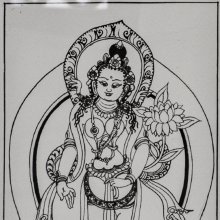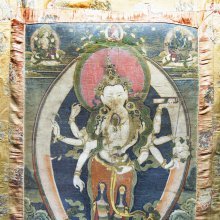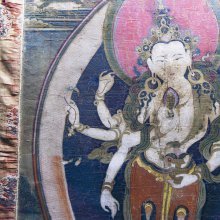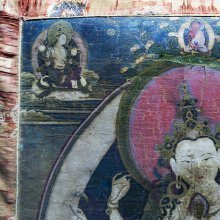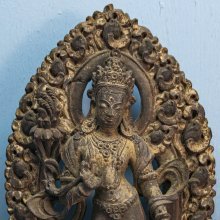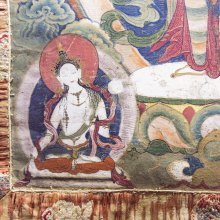Padmapani, Padmapāṇi, Padma-pani: 10 definitions
Introduction:
Padmapani means something in Buddhism, Pali, Hinduism, Sanskrit. If you want to know the exact meaning, history, etymology or English translation of this term then check out the descriptions on this page. Add your comment or reference to a book if you want to contribute to this summary article.
Images (photo gallery)
(+121 more images available)
In Buddhism
Tibetan Buddhism (Vajrayana or tantric Buddhism)
Source: archive.org: The Indian Buddhist Iconography1) Padmapāṇi (पद्मपाणि) is the name of the Bodhisattva offspring associated with Amitābha: one of the Dhyāni-Buddhas, according to Vajrayāna or Tantric Buddhism.—His colour is red; and his symbol is a lotus.—Padmapāṇi is the Bodhisattva attached to the Padma (lotus) family which is presided over by the Dhyāni Buddha Amitābha whose spiritual consort is Pāṇḍarā or Pāṇḍaravāsinī. The Lotus is the symbol of this family and the colour assigned to this family is red. The Bodhisattva Padmapāṇi begets the red colour and a full-blown lotus as his symbol. Padmapāṇi is fairly well represented in the Buddhist countries of the North including Tibet and China.
2) Padmapāṇi (पद्मपाणि) (“lotus bearer”) is another name for Avalokiteśvara: a Bodhisattva commonly depicted in Buddhist Iconography, and mentioned in the 11th-century Niṣpannayogāvalī of Mahāpaṇḍita Abhayākara.—Avalokiteśvara, also called Padmapāṇi () is the spiritual son of the Dhyāni Buddha Amitābha. He is one of the most popular Bodhisattvas of the Buddhist Pantheon having as many as 108 different forms.
3) Padmapāṇi (पद्मपाणि) or Padmapāṇilokeśvara refers to number 104 of the 108 forms of Avalokiteśvara found in the Machhandar Vahal (Kathmanu, Nepal). [Machhandar or Machandar is another name for for Matsyendra.].
Accordingly,—
“Padmapāṇi also is similar in form to [Piṇḍapātra Lokeśvara], with the difference that here the god displays the Varada pose with his right hand and holds the stem of a lotus in his left.—Piṇḍapātra Lokeśvara is one-faced and two-armed and stands on a lotus. He holds the Piṇḍapātra (the bowl) in his two hands near the navel”.
The names of the 108 deities [viz., Padmapāṇi] possbily originate from a Tantra included in the Kagyur which is named “the 108 names of Avalokiteshvara”, however it is not yet certain that this is the source for the Nepali descriptions.Source: OSU Press: Cakrasamvara Samadhi
Padmapāṇi (पद्मपाणि) is the name of a deity, according to the Guru Mandala Worship (maṇḍalārcana) ritual often performed in combination with the Cakrasaṃvara Samādhi, which refers to the primary pūjā and sādhanā practice of Newah Mahāyāna-Vajrayāna Buddhists in Nepal.—Accordingly, “Buddha, I give continual homage, highest Padmapāṇi, spirit of Maitreya, Gaganagañja, Samantabhadra, the elevated friendly ruler of the Yakṣa, Mañjughoṣa, Viṣkambhin, Kṣitigarbha, I bow down before, Khagarbha”.

Tibetan Buddhism includes schools such as Nyingma, Kadampa, Kagyu and Gelug. Their primary canon of literature is divided in two broad categories: The Kangyur, which consists of Buddha’s words, and the Tengyur, which includes commentaries from various sources. Esotericism and tantra techniques (vajrayāna) are collected indepently.
Languages of India and abroad
Sanskrit dictionary
Source: DDSA: The practical Sanskrit-English dictionaryPadmapāṇi (पद्मपाणि).—
1) an epithet of Brahman.
2) Name of Buddha.
3) Name of the sun.
4) of Viṣṇu.
Derivable forms: padmapāṇiḥ (पद्मपाणिः).
Padmapāṇi is a Sanskrit compound consisting of the terms padma and pāṇi (पाणि).
Source: Cologne Digital Sanskrit Dictionaries: Shabda-Sagara Sanskrit-English DictionaryPadmapāṇi (पद्मपाणि).—m. (ṇiḥ) 1. A name of Bramha. 2. The sun. 3. A Buddha, a Baud'dha sanctified teacher. 4. An epithet of Vishnu. E. padma a lotus, and pāṇi the hand holding a lotus in one hand.
Source: Cologne Digital Sanskrit Dictionaries: Cappeller Sanskrit-English DictionaryPadmapāṇi (पद्मपाणि).—[masculine] [Epithet] of Brahman (the lotus-handed).
Source: Cologne Digital Sanskrit Dictionaries: Monier-Williams Sanskrit-English Dictionary1) Padmapāṇi (पद्मपाणि):—[=padma-pāṇi] [from padma] m. ‘lotus-handed’ or ‘holding a l° in the hand’, Name of Brahmā, [cf. Lexicographers, esp. such as amarasiṃha, halāyudha, hemacandra, etc.]
2) [v.s. ...] of Viṣṇu, [Catalogue(s)]
3) [v.s. ...] of the Bodhi-sattva Avalokiteśvara, [Monier-Williams’ Buddhism 195 etc.]
4) [v.s. ...] the sun, [cf. Lexicographers, esp. such as amarasiṃha, halāyudha, hemacandra, etc.]
Source: Cologne Digital Sanskrit Dictionaries: Yates Sanskrit-English DictionaryPadmapāṇi (पद्मपाणि):—[padma-pāṇi] (ṇiḥ) 2. m. A name of Brahmā; the sun; a Buddha.
[Sanskrit to German]
Sanskrit, also spelled संस्कृतम् (saṃskṛtam), is an ancient language of India commonly seen as the grandmother of the Indo-European language family (even English!). Closely allied with Prakrit and Pali, Sanskrit is more exhaustive in both grammar and terms and has the most extensive collection of literature in the world, greatly surpassing its sister-languages Greek and Latin.
Kannada-English dictionary
Source: Alar: Kannada-English corpusPadmapāṇi (ಪದ್ಮಪಾಣಿ):—[noun] any of various deities holding a lotus flower or a lotus-bud, as Lakṣmi, Pārvati, Viṣṇu, Brahma, the Buddha, the Sun-god, etc.
Kannada is a Dravidian language (as opposed to the Indo-European language family) mainly spoken in the southwestern region of India.
See also (Relevant definitions)
Starts with: Padmapanilokeshvara.
Full-text (+4): Aryapala, Abjapani, Abhayaprada, Akalamrityu, Dhanda, Avalokiteshvara, Vajrapani, Chauki, Vishkambhin, Udyata, Maitreyatmaka, Padmapanilokeshvara, Parahitodyata, Parahita, Yakshadhipa, Aparajita, Padmakara, Bhubaneswar, Mahasthamaprapta, Dhanada.
Relevant text
Search found 16 books and stories containing Padmapani, Padmapāṇi, Padma-pani, Padma-pāṇi; (plurals include: Padmapanis, Padmapāṇis, panis, pāṇis). You can also click to the full overview containing English textual excerpts. Below are direct links for the most relevant articles:
Sripura (Archaeological Survey) (by Bikash Chandra Pradhan)
Scultures of Bodhisattvas < [Chapter 3 - Sculptural Programme]
Bronze-icons < [Chapter 3 - Sculptural Programme]
Copper Images < [Chapter 3 - Sculptural Programme]
Garga Samhita (English) (by Danavir Goswami)
Verse 8.13.7 < [Chapter 13 - A Thousand Names of Lord Balarāma]
The Indian Buddhist Iconography (by Benoytosh Bhattachacharyya)
108 forms of Avalokiteśvara (104): Padmapāṇi Lokeśvara
108 forms of Avalokiteśvara (106): Mahāsthāmaprāpta Lokeśvara
The gods of northern Buddhism (by Alice Getty)
Chapter VI - The Principal Forms Of Avalokitesvara
Chapter VII - Forms Of Kwan-Shi-Yin
Matangalila and Hastyayurveda (study) (by Chandrima Das)
Elephants in Buddhist mythology < [Chapter 4]
